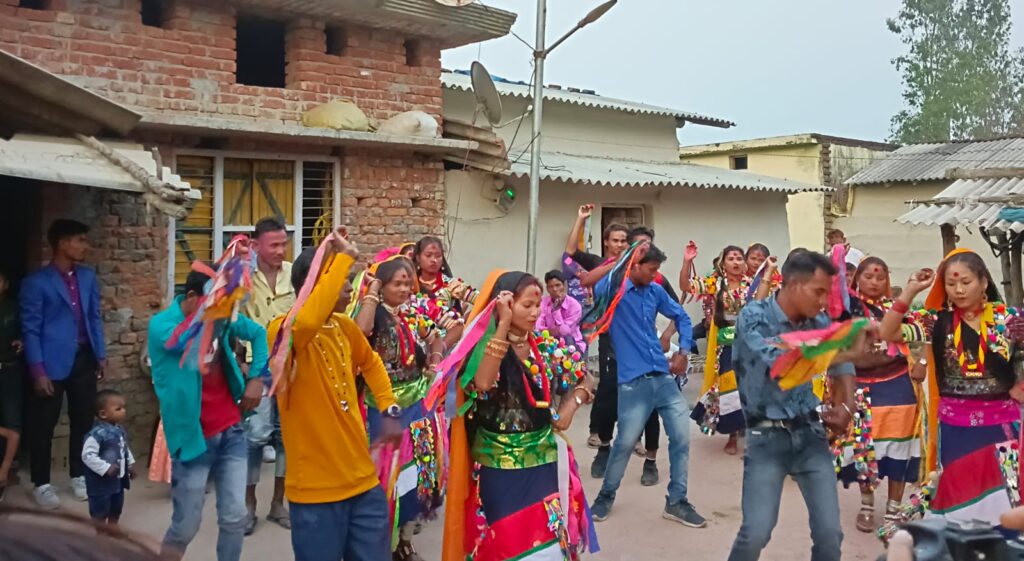Tharu tribe women lead their climate justice movement in India
The Tharu tribe is an indigenous community living in the Terai region between India and Nepal. They are closely associated with the forest and depend on it for their livelihoods. Historically Tharus are related to the descendants of the Rajput clan from Rajasthan, a state in North Western India. They share a strong connection with the forest and the natural resources around them. The ecological knowledge of the Tharus is immense and is well depicted in their lifestyle.
The Dhudhwa Forest gained National Park status in 1977 under the Wildlife Protection Act, and was declared a tiger reserve in 1979 under the Tiger Project. After this, orders of relocation were given to the villages in the core zone, a protected area where human intervention is restricted. Restrictions to access in the forest area often deprive indigenous communities of their subsistence needs and livelihoods.
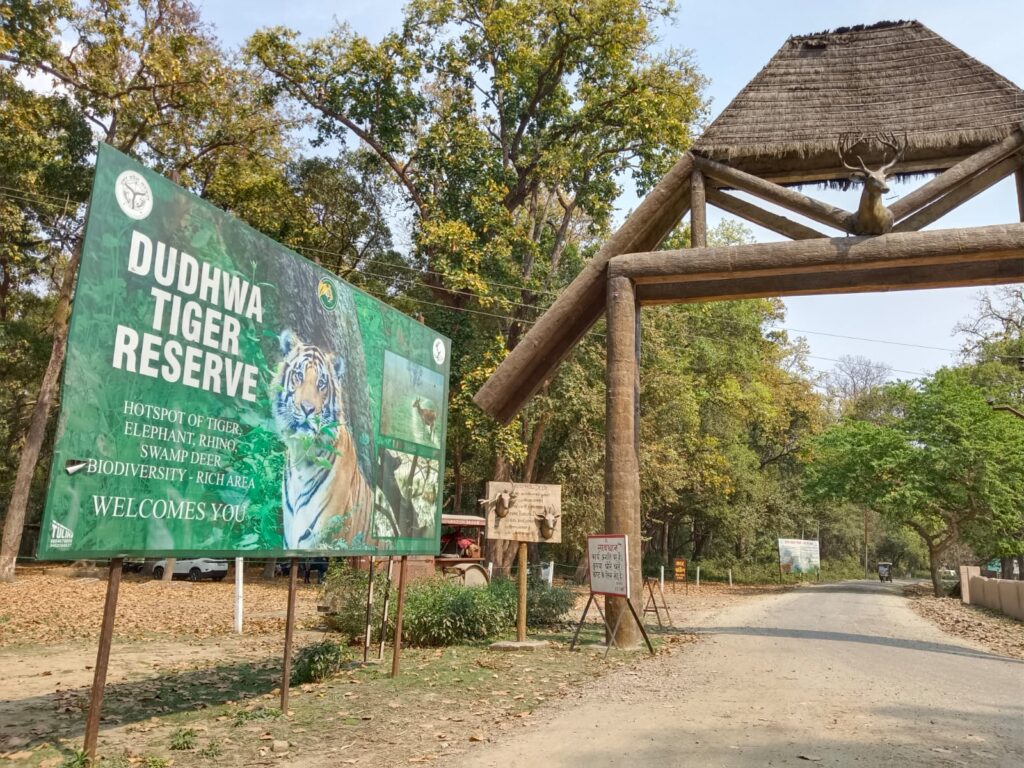
Dipti Arora and Astha Chaudhary
Are we seeking a story, or is courage and wisdom seeking us?
This is the story of three bold Tharu women who have been leading the climate justice movement called Tharu Adivasi Mahila Mazdoor Kisan Manch. Sahvaniya Rana, Nivada Rana and Bhango tai are the women activists belonging to Adivasi Mahila Mazdoor Kisan Manch. The movement was formed in 2009 to fight the legal and social battle under the Forest Rights Act, 2006 (FRA, 2006). The act aims to address the historical injustice the forest-dwelling communities and the traditional forest dwellers in India that the tribal communities have faced at the hands of colonial forest governance models which resulted in the alienation of land, restricted access in the forest areas by granting them rights over their land, forests, and other natural resources which they have been traditionally using. The Tharu community claims their rights under this act, while the forest department continues to assert its control over the forest areas and restricts the entry of the tribal communities who have been living in close association with the forest for generations.
While studying human-wildlife interactions in Uttar Pradesh, my teammate, Astha Chaudhary, and I went to celebrate the festival of Holi with the Tharu tribes. Holi is a joyous occasion, which runs for eight to ten days and involves many rituals. The most important being the Holika dahan, which marks the victory of good over evil. Among the Tharu tribes, the festival is celebrated by singing songs and dancing in their cultural dresses. The songs are mainly related to Lord Shiva and Lord Krishna.
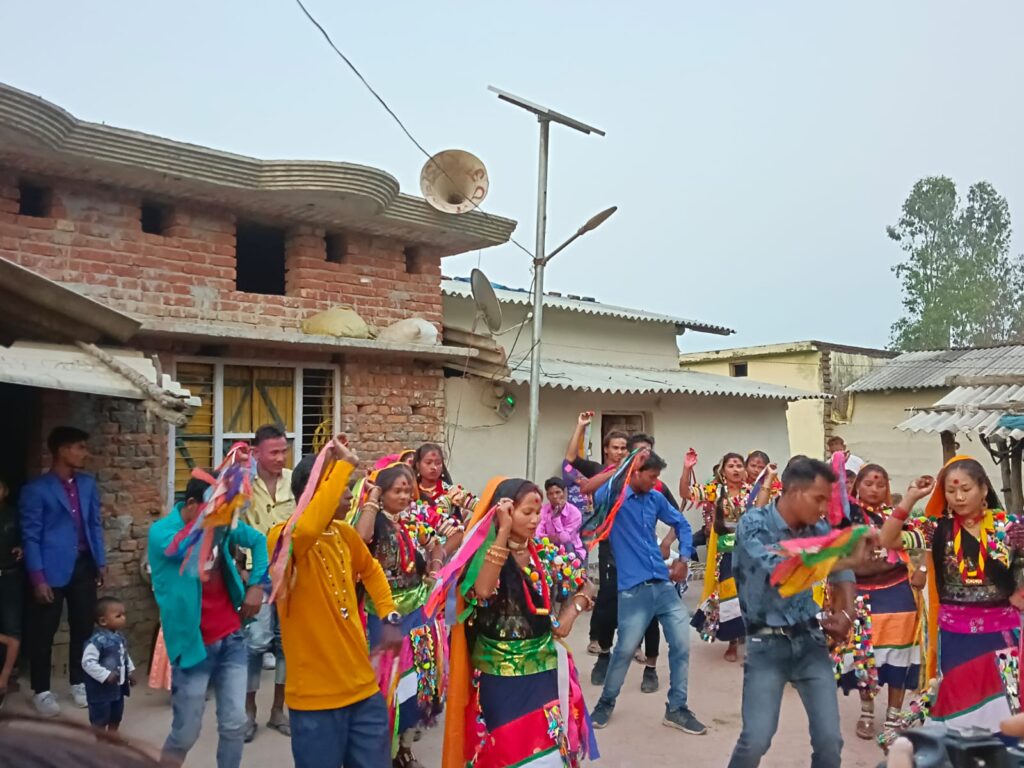
Dipti Arora and Astha Chaudhary
When we arrived at the bus station, Nivada Rana came to meet us and led us to her office. We were supposed to depart for Nivada’s village in the evening on the same day, but due to Holi all the buses were canceled and we decided to leave for the village early in the morning. Sahvaniya had arranged three motorbikes to take us to the village. I decided to accompany Sahvaniya on the ride, who herself is a brilliant motorbike rider. It was early morning around 7:00 am, the Holi had not yet started. We took the short routes through the forests.
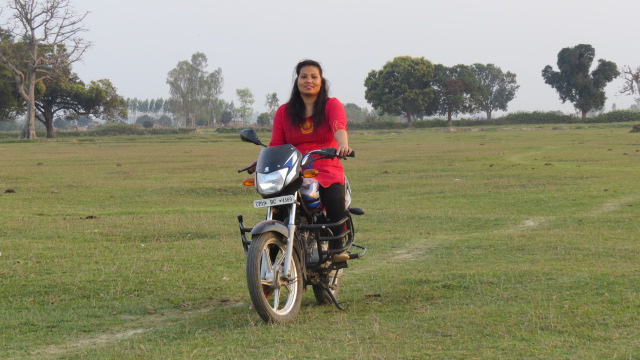
Dipti Arora and Astha Chaudhary
I had read about Sahvaniya in one of her previous interviews and had talked to her over the phone before getting here. Sahvaniya Rana is 25 years old, and is pursuing her law degree and is also the general secretary of Tharu Adivasi Mahila Mazdoor Kisan Manch. She shared in one of the interviews that, “When Dudhwa National Park was established, the locals were not informed and were deprived of their forests and homes by the government for creating the park boundaries. The communities were issued notices for eviction, but the communities decided to fight outrageously. My father, Jawahar Rana and Ramachandra Rana ji, the village pradhan (head), struggled in the court until they finally obtained the Adhikar Patra (Letter of Sanction) for Surma village. As a result, the government can no longer evict us because we had the necessary letter.”
As we crossed through the thick forests of the Dudhwa forest reserve on the bike, Sahvaniya, smiling, said “you are lucky that you got the chance to ride with me and see our forests from inside. If we would have come by bus, you would not have seen it this way. Since we have reclaimed our rights, we can go through the forest. Otherwise, outsiders are restricted in the forests.”
I now understood the earlier interview better. Through the hard-earned struggle of the community, the members of Tharu community were allowed to ride through the forests and not anyone else, without specific permissions.
The morning was an enlightening one, sunbeams were shining through the trees, a mild cold breeze was touching my soul while I was listening to Sahvaniya and pondering over what she explained. It felt like I was having a conversation with the forest that day, where the forest was telling me stories of power and resilience.
After arriving at the village, the conversations started to unfold as we sat and spent some time there. We decided to sit and talk to the women around us. One of them was Nivada Rana, a woman in her 40s who is the president of the movement, a great farmer and a leader as well as an artist who loves to weave and stitch traditional clothes of her community.
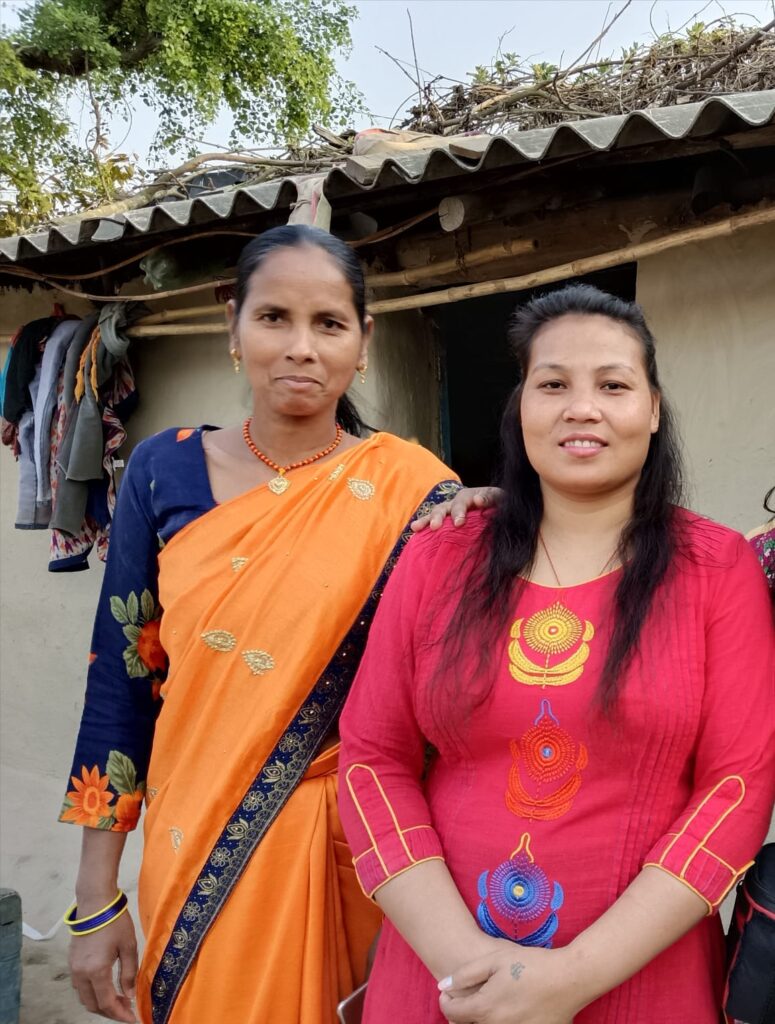
Dipti Arora and Astha Chaudhary
We asked her how she managed to fulfill all these roles. Pointing towards her head she said, “after getting the governmental stamp on my forehead, I am not scared of the oppressors anymore.” She was referring to the scars she got from a tussle between the forest department and a group of locals when they visited the ponds in the forests for fishing.
While the food was being prepared, other women came to Nivada’s house to meet us. Among them was Bhango tai, who is in her 70s. She is a strong, powerful lady usually found on her farm. Each wrinkle on her skin is a crease of experience and knowledge from her lifetime of encounters with the forests. These women share their stories of survival, courage, and longings in the fight for reclaiming forest rights and their relationship with forests and wildlife.
Since we were with three of them, we were curious to hear their stories and learn more about their beliefs and their relationship with the forest. We asked about the wildlife in the region as the area is famous for its wildlife, especially tigers. When we asked Bhango tai, if she had seen a tiger? She smiled and said she once had an encounter with one from a distance. She bowed down and quietly made her way out of there. She explained that her mother had told her stories about tigers and how tigers lived among humans. She shared that Tharus believes that the tigress prefers to give birth to the cubs near human settlements, for their safety. The mother tigress does this to ensure the safety of the cubs, so we should also reciprocate that trust. If we humans do not let her cubs survive and respect their territory, tigers will not harm us either. We were awestruck while listening to her story.
The communities’ beliefs and ideas embrace human and wildlife co-existence while the state policies creating tiger reserves and reserved forest areas disturb this harmonious coexistence. This intrigued us more and we asked her about the tiger reserve which is being made in the forest area. Bhango tai laughed and explained that the policymakers and forest department are not aware of tigers and other wildlife living in the area. “Tharus and tigers have been living together for generations, it is not new for us. But it seems that it is new for the forest department that is why they keep separating humans from the habitats which have been shared with various wildlife species from the old times,” Bhango tai said.
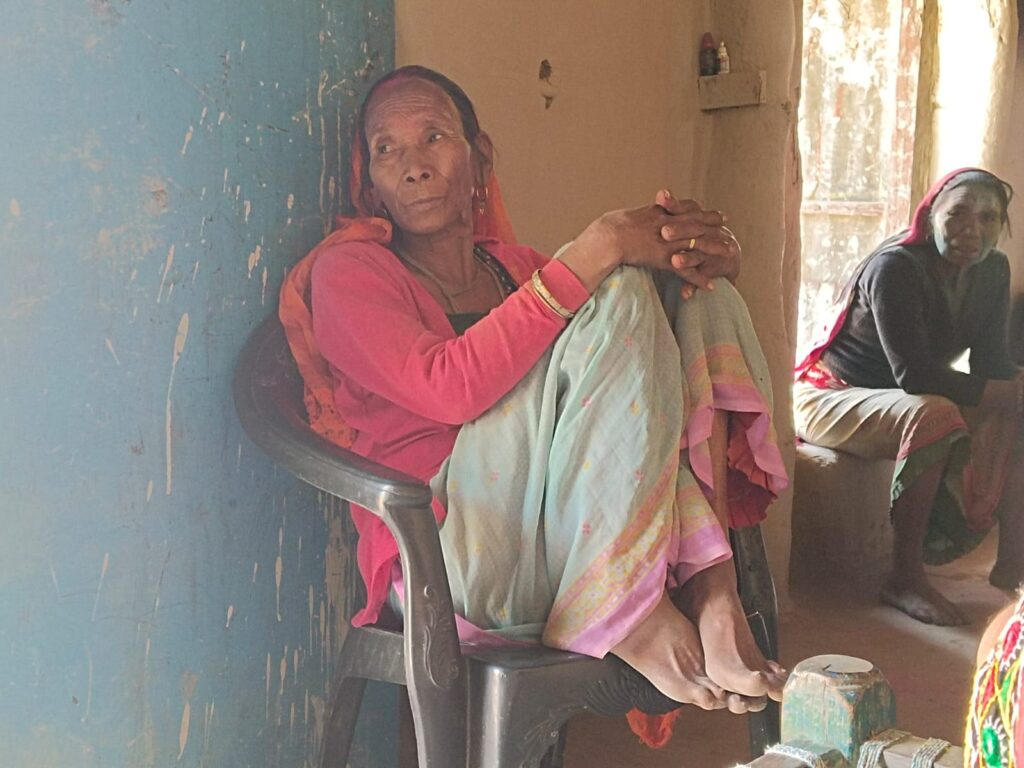
Dipti Arora and Astha Chaudhary
The popular notion among the community for creating the forest reserves and tiger reserves is that the forest department wants to take away tigers and other resources from inside the forests. That is why they do not want any settlements and local people around.
Bhango tai had given us the food for thought for the day. She made us realise the importance of studying human and wildlife coexistence from a local perspective, and recognise our responsibility as researchers to put these narratives and beliefs in the public domain so that the world can learn about what communities think, what their culture is and how it is evolving. With this we also had our lunch, which Nivada had cooked for us. Afterward, Nivada took us to show her village.
“Mud is conducive to success and good fortune to Tharus,” said Nivada. “The mud found on the shoreline of the pond and rivers is collected and a piece of mud mound is placed at the entrance of the house which is the deity and is worshipped.” She continued to share that in her community the mud mound is believed to represent seven sister goddesses.
“See, our houses are built from the materials we bring from the forest,” she said as we made our way inside her home. “These houses protect us from heat, cold, and rain. If we start building only pucca houses, we will become vulnerable to the scorching sunlight, and the rains will flood our homes.”
The sense of utilisation of the forest resources is embedded in their knowledge system. They collect various materials such as grass, wood, and mud from the forest. The roofs are made from the leafy parts of the grass, and the stem of the grass is mixed with mud to be used for covering the walls of the house. The mud and grass acts as an insulator to extreme heat and cold by maintaining the temperature of the house.
The villages are close to the river Mohana which also acts as a transboundary river between India and Nepal. The river overflows in the monsoon and the region is prone to seasonal floods. To deal with this, Tharus has an excellent granary system for storing the grains. The granaries are usually made on the upraised structures supported by wooden pillars. Sahvaniya Rana, also a member of the collective, proudly says, “even if there’s a drought or a famine, the world may suffer but the Tharus will survive longer as we have our cultivated grains and cereal reserves for two years.”
This shows that the communities possess a strong connection with the forest and the natural resources around them. And it is important to document and safeguard this ecological knowledge to combat the narratives of climate change.
After roaming around the village, we again came back to Nivada’s place and had some tea. By the time it was 5:00 pm in the evening, we could hear the sounds of drums and songs from the nearby households. We got our cameras ready to attend the evening rituals of Holi. The festivals of the Tharu tribes also involve cultural celebration of nature. We saw the people dancing in colourful clothes and we were excited to participate. But Sahvaniya stopped us and told us that before we watch the dance we should pay homage to the sacred sand. She made us walk four circular rounds around the area where the villagers had worshipped and completed the rituals. After which we went on to watch the people dance. After the sunset we went back home.
The next morning, we went to meet Bhango tai again. She was on her farm at that time. We were curious to learn more about her and hear more stories.
The struggle for reclaiming forest rights
When we asked Bhango tai about the struggle and how she anticipates the future of the Tharus, she explained that in 2006 the Forest Rights Act was passed and the struggle of the Tharus to reclaim their forest rights began. Forest Rights Act, 2006 takes into account an inclusionary approach to conservation and promotes coexistence. It aims to undo the historical injustices with the indigenous communities in India. The act empowers the community by granting them the ownership status for managing the natural resources. The act grants two types of rights, the community forest rights and individual forest rights to the communities who have been living in the forests for 75 years. Although the act was passed, there is a huge problem with the implementation as communities face various roadblocks to claim their rights.
The complex power dynamics and the colonial laws continue to prevail. Worldwide indigenous people have been subjected to criminalisation and harassment while defending their rights for accessing forests and other natural resources. The welfare department and the state authorities often lack an understanding about the tribes and their culture which gives rise to a continuous strife between the two. Dr Brahma Dutt Sharma, then commissioner of Scheduled castes and scheduled tribes mentioned in his 29th report that the “Criminalisation of communities in tribal areas is the darkest blot on the liberal tradition of India. Tharu women have been subjected to violence and abuse in leading the strong struggle for reclaiming the forest rights.
But their connection to the forests, their livelihoods and a hope for a safer future for their generations make them continue to struggle hard for their rights collectively. Bhango tai boldly asks the forest department authorities if they’ve planted even one tree in the forests. And reminds them that these trees were planted by our ancestors, and our civilizations have grown with them. Pointing towards the forest department office, she says, “even these bricks are made by us. Without us, neither the forests would exist, nor these office buildings”
Way ahead: The need for cultures of solidarities
The story of Tharu tribes in India is a powerful example of climate justice and community resilience. Climate justice movements all around the world are built on the bedrock of shared political and institutional injustices faced by the communities with their origins situated in the history of colonial legacy. With new challenges on the way, the tribes and impacted sections have a long way to go to save their forests and livelihoods.
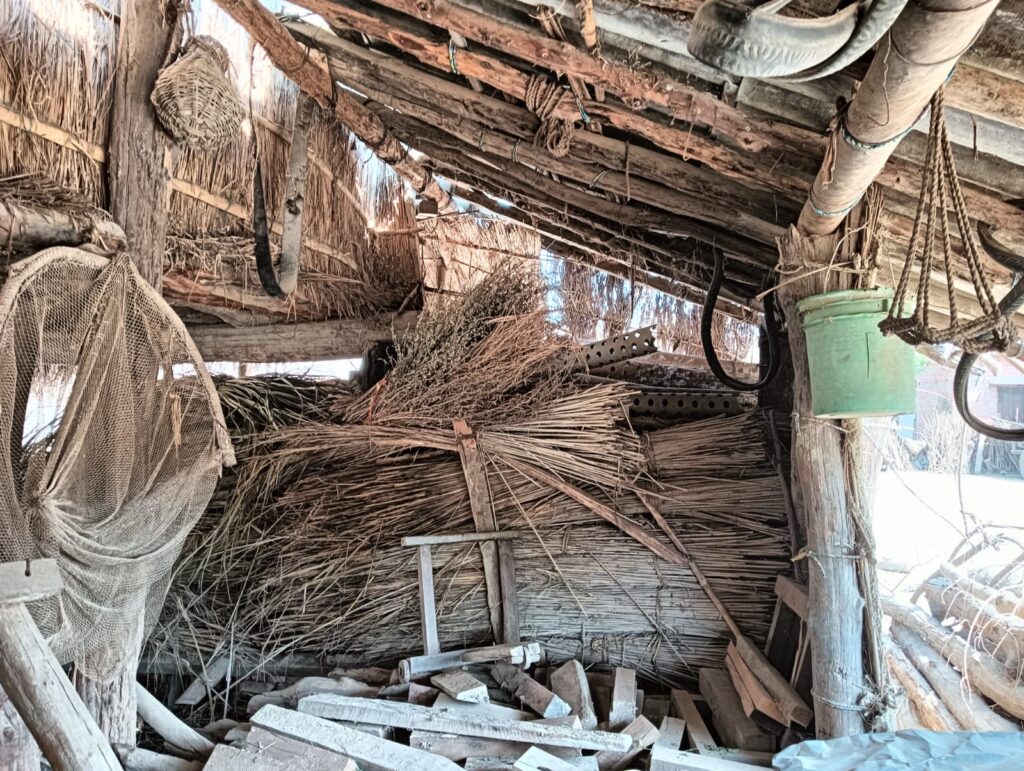
Dipti Arora and Astha Chaudhary
For us, I believe it is important to rethink our lifestyle choices while deciding our lifestyle. It is important to develop a culture of extending solidarities towards collective movements to conserve natural resources and hold the authorities accountable for the same. For a long time, anthropologists and various experts have spoken for the communities, but today, these frontline communities are becoming aware and have their own systems for fighting back. It is the time that we go deep inside, to understand their knowledge systems, and beliefs and let the movements be led collectively.
